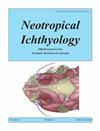建立基线:对受严重影响的河口瓜纳巴拉湾鱼类学组成和分布的调查
IF 2
4区 生物学
Q1 ZOOLOGY
引用次数: 0
摘要
生物多样性基线是评估环境变化和人类活动对群落特殊和时间格局影响的重要依据。这些信息对于促进对历史上受到影响的环境(如巴西东南部的瓜纳巴拉湾)进行适当的保护和管理至关重要。在这里,我们利用收集到的从1889年到2020年的过去数据,包括文献记录、科学收集、生物采样和渔业登陆监测,为该海湾提出了一个鱼类种群基线。共记录硬骨鱼203种,硬骨鱼17种,分属149属(136种硬骨鱼,13种硬骨鱼科)72科(61种硬骨鱼,11种硬骨鱼科),其中虎鲨Galeocerdo cuvier在瓜纳巴拉湾首次记录。虽然所采用的采样努力足以代表河口中上游的鱼系动物,但Chao2估计值表明,从整个海湾来看,鱼系动物的丰富度更高。在过去的几十年里,发现了数量减少和可能的局部灭绝的证据,支持了在该地区实施管理和保护战略的重要性。鱼类分布分析显示,与周围环境相比,靠近保护单元的地区鱼类资源更丰富,这表明这是减轻人类对海湾影响的有效策略。本文章由计算机程序翻译,如有差异,请以英文原文为准。
Building a baseline: a survey of the composition and distribution of the ichthyofauna of Guanabara Bay, a deeply impacted estuary
Abstract Biodiversity baselines are essential subsidies to evaluate how environmental changes and human impacts affect the special and temporal patterns of communities. This information is paramount to promote proper conservation and management for historically impacted environments such as Guanabara Bay, in southeastern Brazil. Here, we propose an ichthyofaunal baseline for this bay using gathered past data from 1889 to 2020, including literature records, scientific collections, biological sampling, and fisheries landing monitoring. A total of 220 species (203 teleosts and 17 elasmobranchs), distributed in 149 genera (136 teleosts and 13 elasmobranchs) and 72 families (61 teleosts and 11 elasmobranchs) were recorded, including the first record of a tiger-shark, Galeocerdo cuvier, in Guanabara Bay. Although the employed sampling effort was sufficient to represent the ichthyofauna in the middle and upper estuary, the Chao2 estimator indicates an even greater richness regarding the bay as a whole. Evidence of reduced abundance and probable local extinction over the decades was found, supporting the importance of implementing management and conservation strategies in the area. The ichthyofaunal distribution analyses revealed that areas close to conservation units are richer compared to their surroundings, indicating that this is an effective strategy to mitigate human impacts in the bay.
求助全文
通过发布文献求助,成功后即可免费获取论文全文。
去求助
来源期刊

Neotropical Ichthyology
生物-动物学
CiteScore
2.80
自引率
17.60%
发文量
24
审稿时长
6-12 weeks
期刊介绍:
Neotropical Ichthyology is the official journal of the Sociedade Brasileira de Ictiologia (SBI). It is an international peer-reviewed Open Access periodical that publishes original articles and reviews exclusively on Neotropical freshwater and marine fishes and constitutes an International Forum to disclose and discuss results of original research on the diversity of marine, estuarine and freshwater Neotropical fishes.
-Frequency: Four issues per year published only online since 2020, using the ‘rolling pass’ system, which posts articles online immediately as soon as they are ready for publication. A searchable and citable Digital Object Identifier (DOI) is assigned to each article immediately after online publication, with no need to await the issue’s closing.
-Areas of interest: Biology, Biochemistry and Physiology, Ecology, Ethology, Genetics and Molecular Biology, Systematics.
-Peer review process: The Editor-in-Chief screens each manuscript submitted to Neotropical Ichthyology to verify whether it is within the journal’s scope and policy, presents original research and follows the journal’s guidelines. After passing through the initial screening, articles are assigned to a Section Editor, who then assigns an Associate Editor to start the single blind review process.
 求助内容:
求助内容: 应助结果提醒方式:
应助结果提醒方式:


